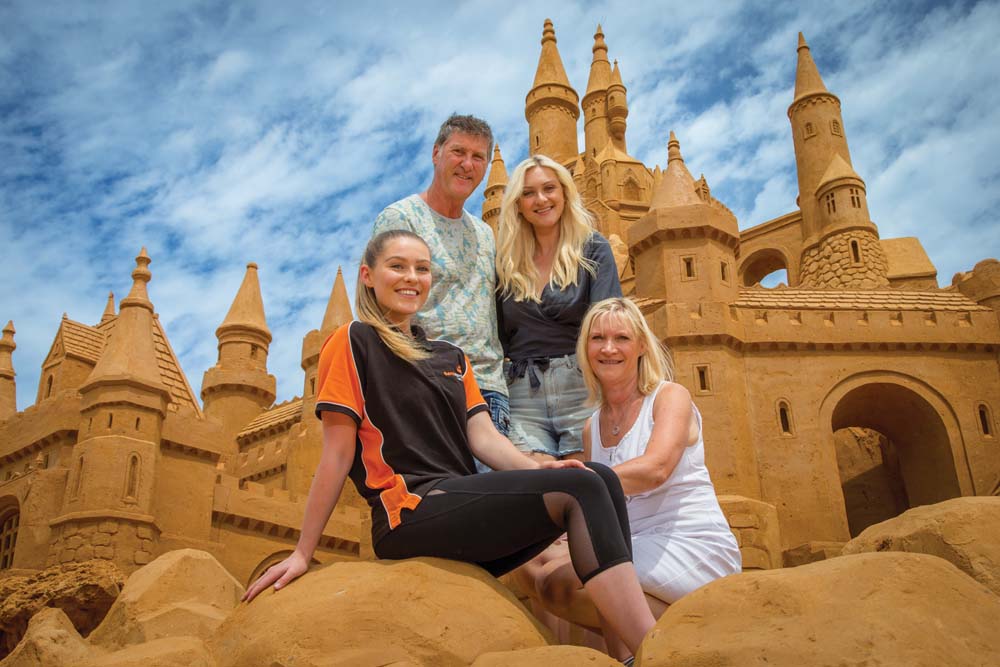
By Melissa Walsh Photos: Gary Sissons
Sharon and Peter Redmond’s love of the beach was the catalyst for their move to Frankston when they first married over two decades ago. But this young couple in love could never have imagined they would end up running a business where they could play amongst the sand every day. Let alone have their two beautiful daughters working alongside them.
These owners of Sandstorm Events and Sand Sculpting Australia have been making sandcastles with their children for 15 years now, ever since Sharon saw her first sand sculpture on the Rye foreshore and was hooked.
“It was back in 2001 and the Rye Action Group was doing a sculpture one weekend. I fell in love with it straight away. What I loved with the sand was that it was something that all generations enjoyed. Parents, grandparents and kids stood there in amazement looking at this sculpture and I knew then that I wanted to bring more of it to the peninsula,” said Sharon, director of Sandstorm Events.
As a woman who has always made things happen, Sharon already had connections in the community after spending many years working with not for profit organisations like Vision Australia and starting the Frankston Lights Festival 20 years ago.
By 2002, Sharon and a team had four sculptures on the foreshore and, in 2005, they were running their own event. These days Sandstorm Events is an award winning sand sculpture event management company and Australia’s largest sand sculpting event company staging four main sand sculpting events around Australia annually and having provided sand sculpture installations for over 350 corporate clients.
“We originally kept the exhibition in Rye and it was great for years but we wanted to grow it in terms of size which meant being open to the public longer. As we couldn’t utilise the foreshore in Rye during December and January we put out the feelers for Frankston,” said Sharon, on their move from Rye to the current Frankston foreshore location nine years ago. “Here we are open from December through to after Anzac Day, and it has greater access to public transport for visitors. When we left Rye, we had 50,000 to 60,000 visitors a season. In Frankston, we average between 130,000 to 150,000.”
The evolution of the business has been a lovely surprise for Sharon and Peter, particularly with the girls’ continual involvement, from the time they were in primary school running the souvenir shop, and with Peter’s flair for sand sculpting itself.
“It’s been an interesting journey. I fell in love with this and then Peter was drawn to the sand to sculpt. Our daughter Shelby finished her marketing and public relations degree at university and came back here to work even though she was offered a job at a TV station. Our youngest Taylah, is studying marketing at the moment but still works here during holidays,” says Sharon, who explains she still gets a thrill when she sees the enjoyment on people’s faces. “We also see ourselves as educators and enjoy explaining to people the process of creating the sculpture from start to finish.”
Creating the magical sand sculpture event that just seems to pop up on the foreshore at the same time every year, takes a lot of work. The unused grassed area has 3,500 tons of local sand dumped there to be pounded up, gravel is supplied for the pathways and fences have to be erected. In 14 days, 22 sculptors work 12 hour days in the heat, rain and cold, to create the themed sculpture exhibition.
This is when Peter really steps in, taking his place amongst other local and international sculptors.
“All the sculptors are given a drawing of their character or area, which has been chosen by Shelby and Sharon according to the sculptor’s strengths. We use brickies loam sand which has ultra-minute particles that fill the gaps between the grains so the density of the sand is what gives it its strength. If you have heavy rain, it will damage the surface but that is repairable. We have our concept drawing and then pull the top forms off and start blocking things out. Once you have your basic shape and are happy with the profile, you work your way down. It’s all about removing sand,” said Peter. “The pack-up in April takes about four weeks, removing the sand, reseeding and restoring the grass, and removing the fences.”
As for where all that sand goes when the sculptures disappear, Sharon says that is one of the most amazing things.
“Every year the sand on the ground gets tipped, the sand up the top is stored in a pile and the sand making the bases is stored in another pile and each year we bring fresh sand here to top it up. So some of the sand we still use could have been in our very first sculpture exhibition,” said Sharon.





